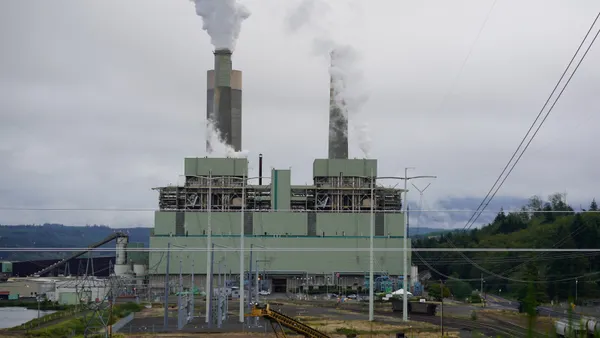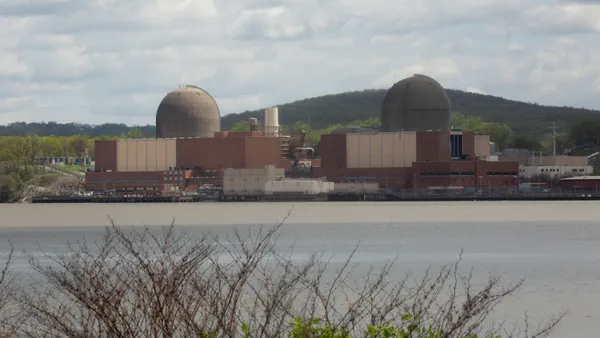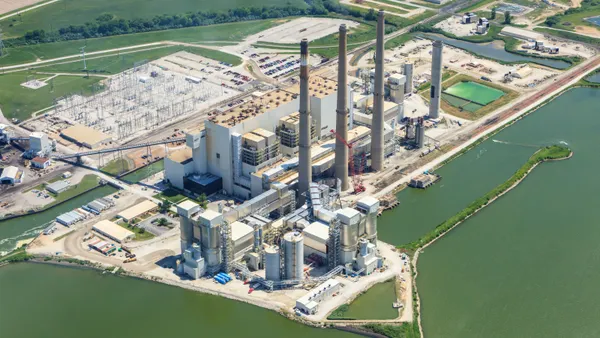Dive Brief:
-
Duke Energy Progress and Duke Energy Carolinas on Tuesday released their 2020 integrated resource plan, mapping out potential avenues for the utility to reach 70% carbon reductions by 2030.
-
Of the utility’s three most ambitious carbon reduction scenarios, one would rely in part on adding 1,350 MW of small modular reactors, one includes 5,500 MW of onshore and offshore wind and a third would not add any natural gas, but would likely keep 2,200 MW of coal online through 2035, retiring the units when it is "most economic" to do so. Two other scenarios would also leave coal plants online through 2035 — a base case without carbon policy and a base case with carbon policy. All other scenarios outside the no gas model would continue adding anywhere from 6,100 to 9,600 MW of gas through 2035.
- The utility does not have a preferred scenario, according to Glen Snider, director of integrated resource planning and analytics at Duke, though it does point out in its IRP some of the drawbacks of the nuclear, offshore wind and no gas scenarios — namely that the three rely on technologies that aren’t fully mature technologically or economically.
Dive Insight:
Duke Energy in September of last year committed to reaching net-zero carbon emissions by 2050 and reducing carbon emissions 50% below 2005 levels by 2030. But shareholders and other stakeholders have questioned whether the utility was being ambitious enough with its nearer-term goals, in particular criticizing what they saw as an over reliance on natural gas buildouts reaching into the 2030s.
Thursday’s filing lays out a number of potential paths for the utility to take to 2030 and 2035, including a no gas scenario that would have the utility add 7,400 MW of storage capacity, 3,350 MW of demand response and energy efficiency, 700 MW of small modular reactors, 5,800 MW of offshore and onshore wind and 16,400 MW of solar power. It would also keep 2,200 MW of coal online through 2035 and include a revenue requirement of $108.1 billion through 2050, including $8.9 billion on transmission.
The no gas scenario and the small nuclear plan rely most heavily on technology and policy advancement within the next decade.
"If we're not going to have new gas to be able to count on as a transition resource on that path to net zero, we'll have to rely on other technologies earlier," said Snider. "Technologies, like offshore wind, like battery storage, are going to get cheaper across time. Small modular reactors, same thing. … We wouldn't say it's not possible, it just creates some economic and technology risks that are going to have to be part of the public policy discussion."
Though the utility doesn’t specifically call out any policy positions, it says any carbon policy should be "significant enough to effectuate change in the technology selections, but not so drastic as it's a cost shock to the consumer," Snider said.
In other scenarios, including its base case with a carbon policy, the utility would continue its gas buildouts into the 2030s. The base case scenario that includes a carbon policy has an $82.5 billion revenue requirement, including $1.8 billion in transmission.
In its base case with a carbon policy, the utilities generation mix would include 12,300 MW of solar additions with 2,200 MW paired with storage by 2035, plus 750 MW of wind and 7,350 MW of gas across Duke Energy Progress and Duke Energy Carolinas.
Environmentalists credited Duke for improvements in storage scenarios, but remain concerned about projected gas buildouts and a reluctance to retire coal more quickly.
"[A]s Duke makes abundantly clear, this isn't a commitment to retire anything (other than Allen 1-3, which is locked in by a consent decree). So, we've still got work to force even the most modest steps," Dave Rogers, southeast deputy regional director for the Sierra Club, said in a Tweet.














